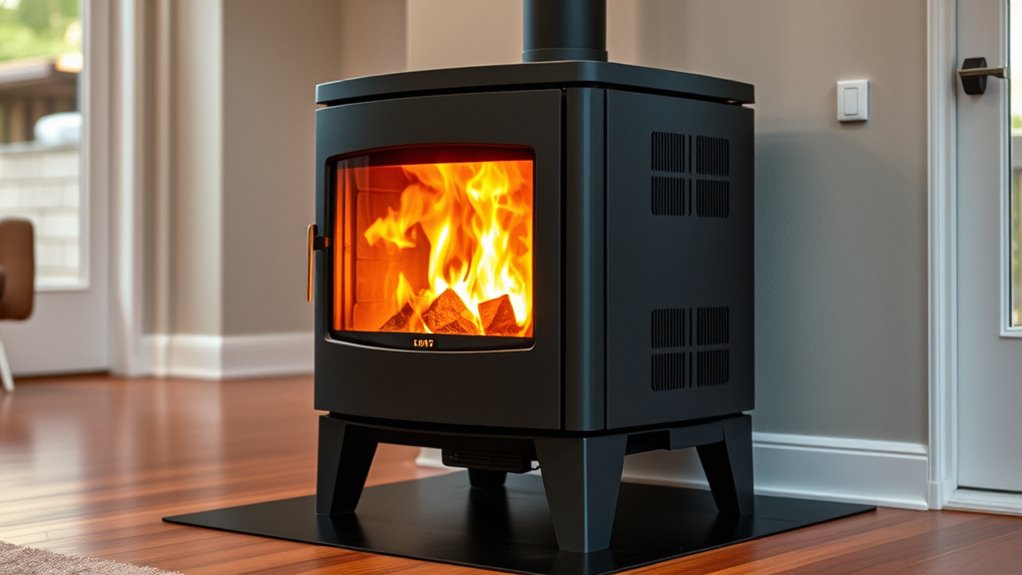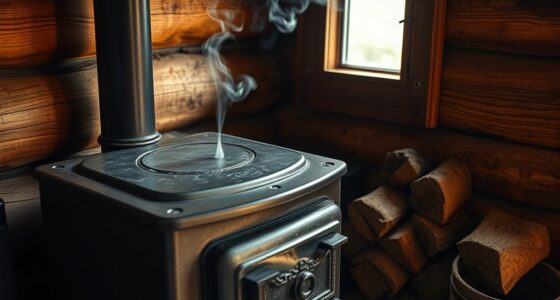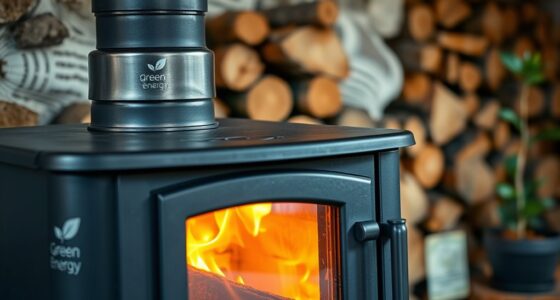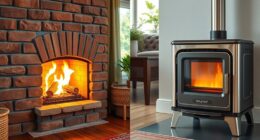Modern wood stove innovations focus on cleaner, more efficient heating by using advanced combustion techniques, smart controls, and sustainable materials. You’ll benefit from automated airflow systems that optimize burn rates, better heat exchange designs, and sensors that monitor emissions for safety. These features reduce emissions, improve fuel efficiency, and enhance safety. If you want to discover how these technologies can transform your heating experience and help you save energy, keep exploring the options available.
Key Takeaways
- Advanced combustion chambers with secondary burn technology maximize fuel efficiency and reduce emissions.
- Integrated sensors and smart controls optimize airflow and temperature for cleaner, more efficient burning.
- Use of sustainable, recycled materials and eco-friendly fuels lowers environmental impact.
- Double-wall insulation and heat exchange systems improve heat retention and distribution.
- Safety features like automatic shut-offs and emission monitoring enhance performance and environmental compliance.
Advanced Combustion Technologies for Reduced Emissions
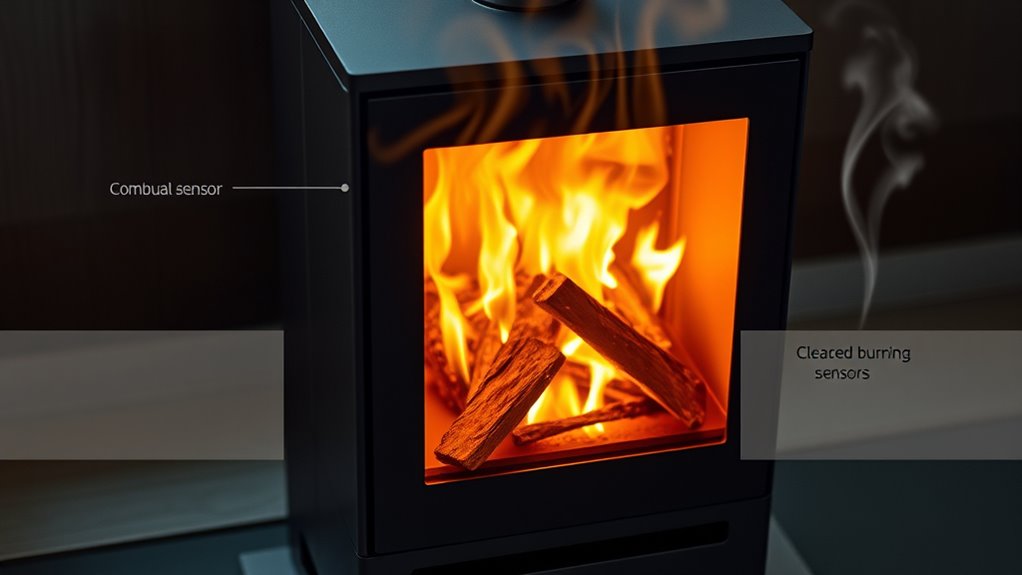
Have you ever wondered how modern wood stoves are becoming cleaner and more efficient? One key advancement is the use of ceramic insulation within the combustion chamber. This material helps retain heat, ensuring a more complete combustion process. As a result, you get fewer emissions and better fuel efficiency. The ceramic insulation keeps the heat concentrated, reducing energy loss and allowing the stove to burn wood more thoroughly. This not only minimizes smoke and particulate matter released into the air but also maximizes heat output. By optimizing the combustion chamber design with ceramic insulation, manufacturers create stoves that are both environmentally friendly and cost-effective. Furthermore, incorporating advanced combustion technology improves overall stove performance and reduces emissions even further, aligning with emission reduction goals in modern heating solutions. Additionally, innovations such as smart controls enable better regulation of combustion for enhanced efficiency and user convenience. Recent developments in insulation materials are further enhancing the thermal retention and efficiency of these stoves, contributing to sustainable heating efforts worldwide.
Automated Airflow Control Systems
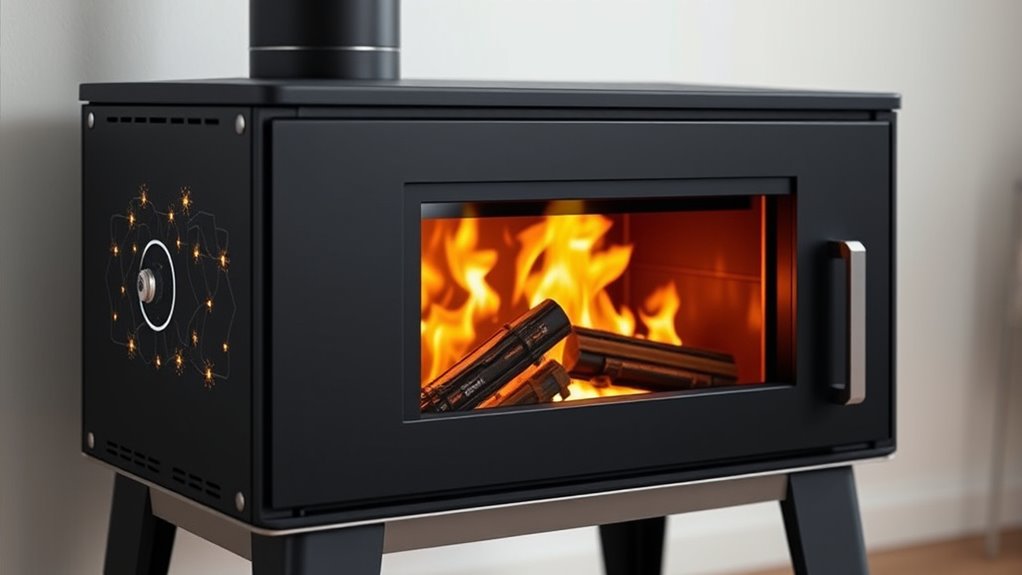
Automated airflow control systems are transforming how modern wood stoves operate by precisely regulating the amount of air entering the combustion chamber. With automated airflow, you can maximize combustion control, ensuring your stove burns efficiently and cleanly. These systems automatically adjust airflow based on real-time data, such as temperature and burn rate, reducing manual intervention. As a result, you experience more consistent heat output and lower emissions. This technology helps maintain ideal combustion conditions, minimizing fuel waste and smoke production. You’ll notice easier operation and improved safety since the system prevents over-firing or smoldering fires. Overall, automated airflow control systems make your wood stove smarter, cleaner, and more efficient, delivering better performance with less effort on your part.
Eco-Friendly Materials and Sustainable Design
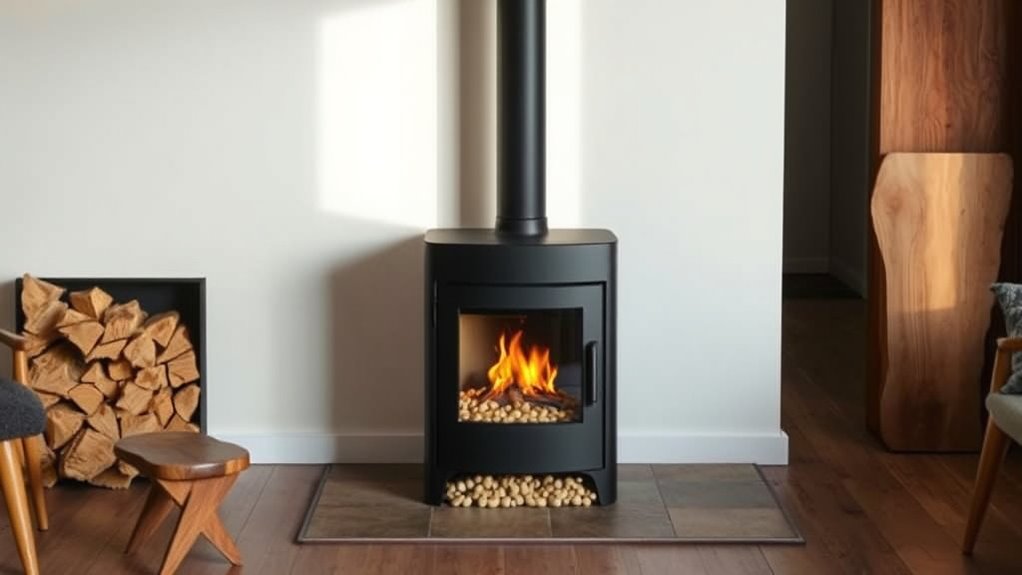
You can choose stoves made with recycled metal components that reduce waste and conserve resources. Manufacturers now use low-impact processes to lower environmental footprints during production. Additionally, exploring sustainable fuel options helps you burn cleaner and support eco-friendly practices sustainable forestry. Incorporating advanced insulation materials can further enhance efficiency by minimizing heat loss and reducing fuel consumption. Many modern designs also incorporate energy-efficient technologies to maximize performance while minimizing environmental impact. Implementing environmentally responsible manufacturing practices ensures that the entire lifecycle of the stove aligns with sustainability goals.
Recycled Metal Components
Recycled metal components are transforming modern wood stove design by offering a sustainable alternative to traditional materials. Using recycled metal reduces mining and energy consumption, making your stove more eco-friendly. These components, crafted from reclaimed steel or cast iron, maintain durability while supporting sustainability efforts. Incorporating recycled metal also aligns with eco conscious packaging practices, ensuring minimal waste and a smaller environmental footprint. By choosing stoves with recycled metal parts, you contribute to reducing landfill waste and conserving resources. This approach not only improves the stove’s overall efficiency but also promotes responsible manufacturing. Additionally, advancements in toilet cleaner effectiveness ensure that these eco-friendly materials are properly maintained without sacrificing performance. Incorporating sustainable manufacturing practices further enhances the environmental benefits of using recycled metals. As a consumer, your choice helps drive innovation toward greener, more sustainable heating solutions that don’t compromise on performance or quality.
Low-Impact Manufacturing Processes
While traditional manufacturing methods often rely on resource-intensive processes, many modern wood stove producers are now embracing low-impact manufacturing to minimize environmental effects. They prioritize eco-friendly materials and sustainable design choices, reducing waste and pollution. You’ll notice that these companies often use recycled packaging to cut down on waste and promote reuse. Additionally, biodegradable finishes are becoming popular, as they offer a safe alternative to harmful chemicals, ensuring the product’s end-of-life impact is minimized. Other initiatives include sourcing sustainable materials, reducing energy consumption during production, and designing for longevity to prevent early disposal. Sustainable materials and eco-conscious production methods are increasingly adopted to improve environmental sustainability. By adopting these practices, manufacturers not only lessen their footprint but also provide you with greener, more responsible heating options. Innovative design techniques are increasingly used to enhance energy efficiency and product lifespan. Incorporating environmentally friendly manufacturing processes can further reduce overall ecological impact and support long-term sustainability goals, especially through efficient resource use.
Sustainable Fuel Options
Have you considered how the type of fuel your wood stove uses can impact the environment? Switching to sustainable fuel options makes a significant difference. Biomass briquettes, made from compressed organic waste, burn cleaner and produce less smoke and emissions. They’re a renewable alternative to traditional firewood, reducing deforestation and waste. Bioethanol fuels, derived from fermented plant materials, offer an eco-friendly option that burns efficiently with minimal soot. These fuels not only lower your carbon footprint but also support sustainable energy practices. Modern stoves are designed to optimize the combustion of biomass briquettes and bioethanol fuels, ensuring cleaner heat with less environmental impact. Utilizing energy efficiency ratings for fuels and stove design can further enhance performance and sustainability. Choosing these sustainable fuel options promotes eco-conscious living while maintaining effective warmth and comfort. Additionally, utilizing renewable energy sources for fuel production can further reduce the environmental footprint of your heating system.
Improved Heat Exchange and Distribution
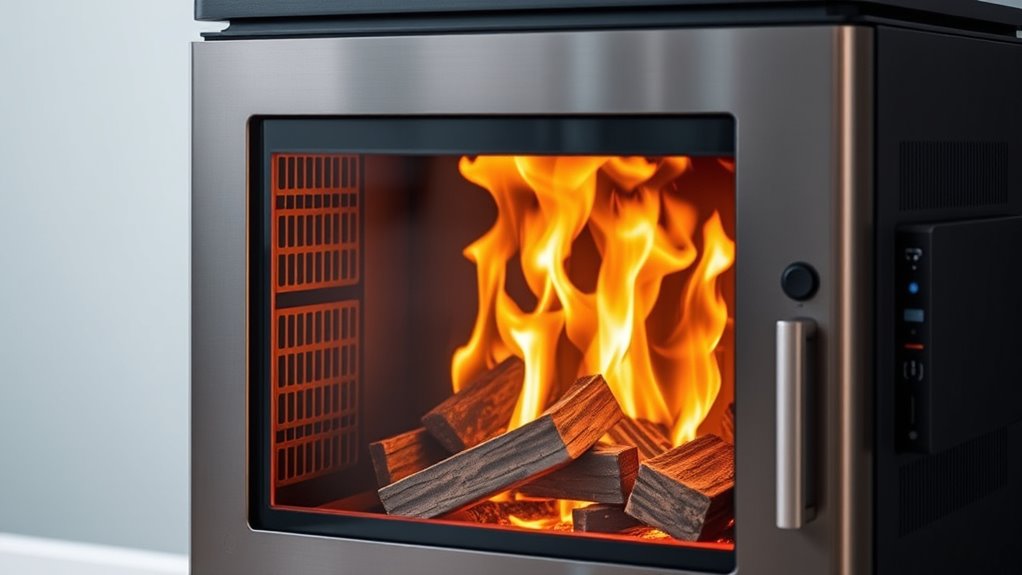
Advancements in heat exchange and distribution are transforming how modern wood stoves deliver warmth. By focusing on airflow optimization, these stoves ensure heat moves efficiently throughout your space. Improved heat distribution means less hot spots and more consistent warmth, making your home cozier. Key innovations include:
- Enhanced air channels for better airflow
- Double-wall construction for increased heat transfer
- Cast iron and steel designs for durability
- Integrated fans for forced convection
- Sealed combustion systems for safer operation
These features work together to maximize heat exchange, reducing fuel use and emissions. Incorporating heat transfer efficiency can also help improve indoor air quality by capturing allergens and fine dust. Additionally, advancements in combustion technology enhance the overall efficiency and environmental friendliness of modern wood stoves. Modern designs now often include airflow management systems that further optimize heat distribution. Moreover, incorporating temperature control systems allows for precise regulation of heat output, enhancing comfort and safety. As a result, you enjoy a more even, efficient heating experience, saving energy and money. Modern design and engineering truly elevate your comfort, making your wood stove a smarter heating choice.
Integration of Smart Technology and IoT
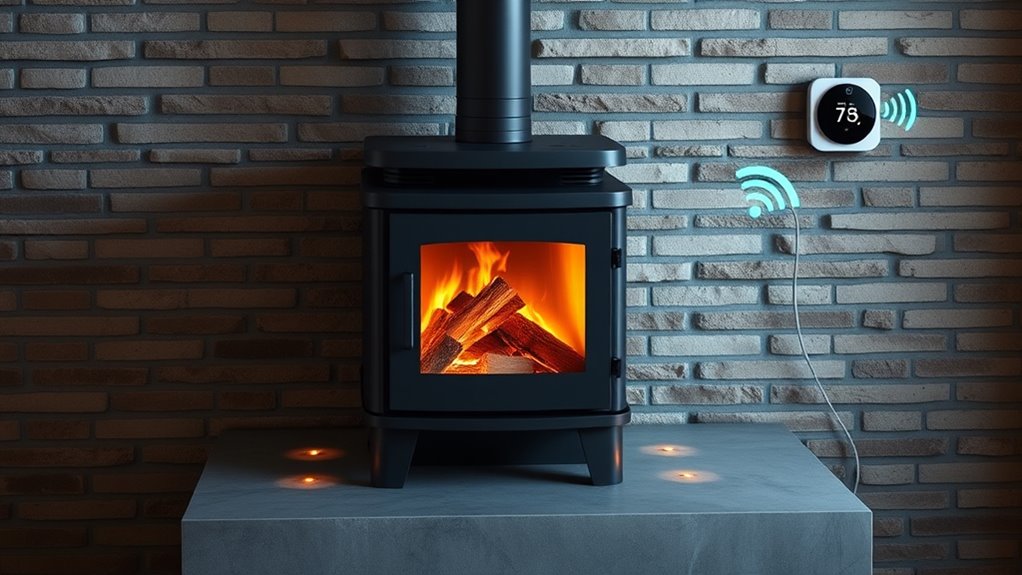
Smart technology and IoT integration are revolutionizing how you control and optimize your wood stove. With voice control, you can adjust settings hands-free, making stove management more convenient and precise. Remote monitoring allows you to track your stove’s performance, burn rates, and temperature from anywhere using your smartphone or tablet. These features help you fine-tune combustion for cleaner emissions and more efficient heating. You can receive alerts if the stove needs attention or if safety thresholds are reached. This seamless integration gives you greater control over your heating system, enhancing safety, efficiency, and convenience. Additionally, tuning your system can optimize fuel consumption and reduce emissions, resulting in a more environmentally friendly heating solution. Integrating smart technology also enables you to monitor emissions in real-time, ensuring your home stays environmentally compliant. This ongoing monitoring and adjustment process helps prevent potential vulnerabilities and keeps your system secure. Leveraging AI security in your smart system can further safeguard your connected devices from cyber threats. Implementing these innovations can also lead to improved system diagnostics, allowing you to identify and address issues proactively. By connecting your wood stove to smart technology, you’re taking a significant step toward smarter, more sustainable home heating.
Innovations in Fuel Efficiency and Burn Rates
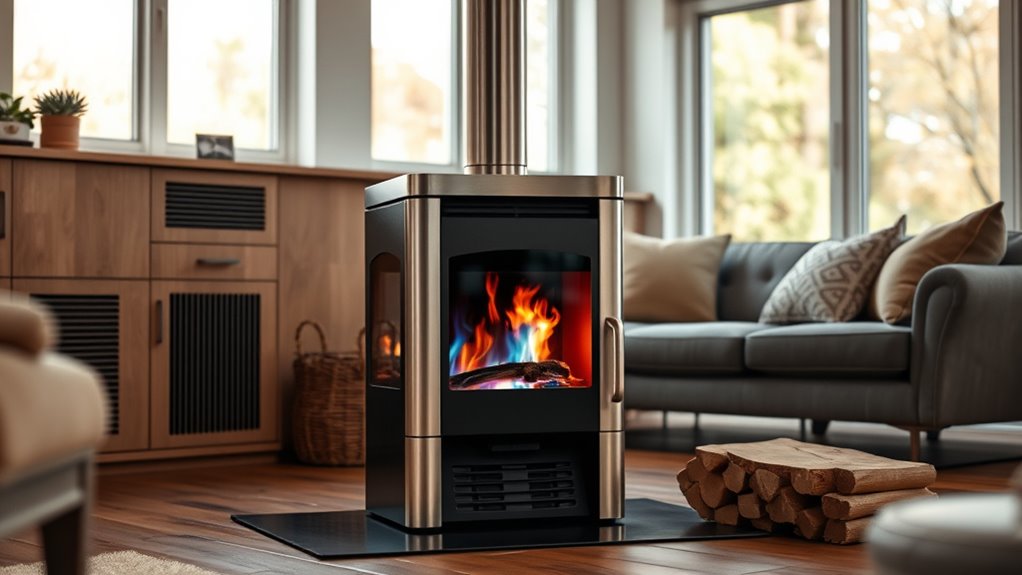
Recent innovations in wood stove design are considerably improving fuel efficiency and burn rates, helping you get more heat from less wood. Advanced combustion systems optimize airflow, ensuring complete burning and less wasted fuel. Features like secondary combustion chambers reburn gases for increased efficiency. Proper wood stove maintenance, including chimney cleaning, prevents creosote buildup that hampers performance. Modern stoves also incorporate adjustable air intakes for precise control. Upgraded insulation minimizes heat loss, maximizing burn time. These innovations mean you use less wood while maintaining consistent warmth. Regularly checking and maintaining your stove ensures peak performance. Improvements in burn technology reduce emissions and extend fuel life, making your heating more economical and eco-friendly. Staying on top of chimney cleaning and maintenance helps sustain these efficiencies over time.
Enhanced Safety Features and Emission Monitoring
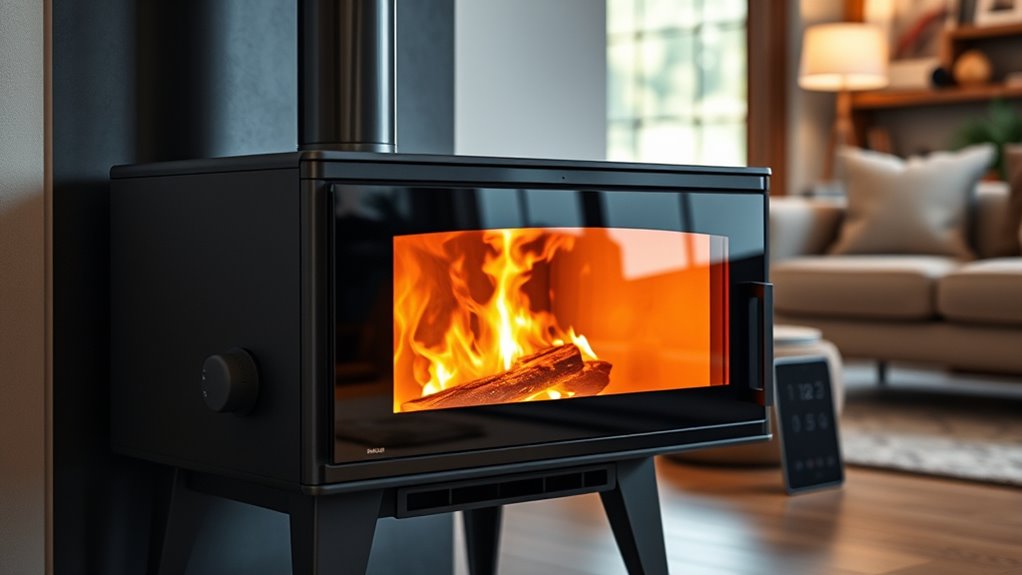
As modern wood stove technology evolves, enhanced safety features and emission monitoring systems play a essential role in protecting your home and the environment. Advanced sensors now detect dangerous emissions and alert you before they become problems, ensuring cleaner operation. Safety mechanisms like automatic shut-offs activate if temperatures exceed safe limits, preventing fires. Many stoves incorporate firebrick aesthetics that not only enhance durability but also reflect artisanal craftsmanship, blending safety with style. These features make your stove safer and more efficient, reducing harmful emissions and improving indoor air quality. You gain peace of mind knowing your stove is equipped with the latest safety innovations, all while maintaining the classic charm and craftsmanship that make your heating system both functional and visually appealing.
Design Trends for Modern Aesthetics and Functionality
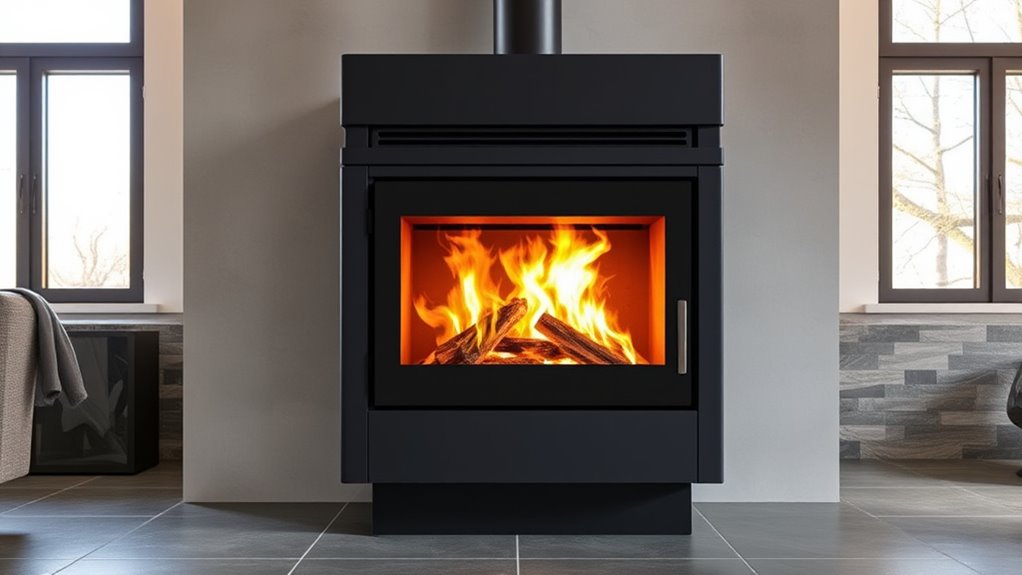
Modern wood stove design seamlessly combines sleek aesthetics with practical functionality, reflecting contemporary tastes while enhancing performance. You’ll notice a focus on artistic expression, blending form and function to create visually striking pieces that also maximize heat output. Many designs draw inspiration from historical influences, integrating vintage details with modern materials.
Modern wood stoves blend sleek design with high efficiency, inspired by vintage details and contemporary artistry.
Consider these trends:
- Minimalist geometric shapes for a clean look
- Matte finishes and bold color options
- Artistic embellishments inspired by traditional craftsmanship
- Multi-functional designs with integrated storage
- Large glass doors to showcase the fire, emphasizing aesthetics
These elements not only elevate your space’s style but also serve practical purposes, making your stove a true centerpiece that marries historical charm with modern innovation.
Frequently Asked Questions
How Long Do Modern Wood Stoves Typically Last With Proper Maintenance?
Your modern wood stove typically lasts between 10 to 20 years with proper maintenance practices. Regular cleaning, inspecting for rust or damage, and replacing worn parts help extend the stove’s lifespan. If you stay diligent with upkeep, you can enjoy efficient, cleaner heat for many years. Proper maintenance not only maximizes your stove’s durability but also guarantees safe operation, making it a worthwhile investment over time.
Are There Specific Certifications to Look for in Eco-Friendly Wood Stoves?
When choosing an eco-friendly wood stove, you should look for certification standards like EPA certification, which guarantees the stove meets strict emissions limits. Additionally, check for eco label programs that verify energy efficiency and environmental impact. These certifications help you identify stoves that are cleaner, more efficient, and better for the environment, giving you confidence that your purchase supports sustainable heating while complying with recognized standards.
Can Smart Technology in Wood Stoves Be Integrated With Home Automation Systems?
Imagine controlling your wood stove effortlessly—sounds futuristic, right? Smart technology in wood stoves now seamlessly integrates with your smart home system, allowing automation integration for temperature management, remote control, and safety alerts. This innovation elevates comfort and convenience, making traditional heating smarter and more efficient. With the right setup, you can enjoy personalized warmth with just a few taps, transforming your home into a truly connected, intelligent space.
How Do Modern Stoves Handle Different Types of Wood or Biomass Fuels?
You’ll find that modern stoves are designed for fuel flexibility, allowing you to burn various types of wood or biomass fuels. They optimize burn efficiency by adjusting airflow and combustion settings based on the fuel used. This means you can switch between hardwood, softwood, or other biomass materials without sacrificing performance or cleanliness, making your heating system more adaptable and efficient regardless of fuel type.
What Are the Typical Costs and Savings Associated With Upgrading to a Modern Wood Stove?
Upgrading to a modern wood stove can be cost-effective, with a typical cost analysis showing payback within 2-5 years due to fuel savings. You might spend $2,000 to $4,000 initially, but improved efficiency reduces your annual fuel costs by up to 40%. This means you’ll save hundreds each winter while enjoying cleaner, safer heat. Over time, this investment pays off through lower energy bills and environmental benefits.
Conclusion
As you embrace these modern wood stove innovations, you’re stepping into a world where warmth and sustainability dance in harmony. Think of your stove as a symphony of advanced tech and eco-conscious design, transforming your space into a cozy haven that breathes cleaner air. With smarter controls and greener materials, you’re not just heating your home—you’re fueling a brighter, cleaner future. Let these innovations light the way to a warmer, more sustainable tomorrow.

